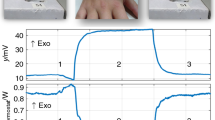Abstract
Scientists use passive heat flow meters to measure body heat exchanges with the environment. In recent years, several such sensors have been developed and concerns about their proper calibration have been addressed. However, calibration methods have differed in the geometry of the heated device as well as in the heat transfer mechanism. Therefore, a comparison of calibration methods is needed in order to understand the obtained differences in calibration lines. We chose three commercially available heat flux sensors and placed them on four different heated devices: a hot plate, double hot plate, nude cylinder and a cylinder covered with a spacer material. We found differences between the calibration line of the manufacturer and our own measurements, especially when forced convection was involved as the main heat transfer mechanism. The results showed clearly that the calibration method should be chosen according to the intended purpose of use. In addition, we recommend use a thin, light heat flux sensor with good thermal conduction in human subject studies.

Similar content being viewed by others
References
Basset FA, Cahill F, Handrigan G, Ducharme MB, Cheung SS (2011) The effect of lower body cooling on the changes in three core temperature indices. Physiol Meas 32:385–394
Bell PY, Padbury EH, Hayes PA (1985) Optimal siting of heat flux transducers for the assessment of body heat loss when immersed in water. Undersea Biomed Res 12:465–483
Cannon P, Keatinge WR (1960) The metabolic rate and heat loss of fat and thin men in heat balance in cold and warm water. J Physiol 154:329–344
Choi JK, Lee HS, Park YS, Shiraki K (2003) Effect of uniform and non-uniform skin temperature on thermal exchanges in water in humans. Int J Biometeorol 47:80–86
Close WH, Dauncey MJ, Ingram DL (1980) Heat loss from humans measured with a direct calorimeter and heat-flow meters. Br J Nutr 43:87–93
Danielsson U (1990) Convective heat transfer measured directly with a heat flux sensor. J Appl Physiol 68:1275–1281
Ducharme MB, Frim J (1991a) Methodoloy for calibration and use of heat flux transducers. Institute of Environmental Medicine. Downsview, Ontario
Ducharme MB, Frim J (1991b) Methodoloy for calibration and use of heat flux transducers Institute of Environmental Medicine, Downsview, Ontario
Ducharme MB, Kenny GP (2009) A calorimetric validation of evaporative and dry heat losses measured with heat flow transducers. Paper presented at the 13th International Conference on Environmental Ergonomics, Boston
Ducharme MB, Frim J, Tikuisis P (1990) Errors in heat-flux measurements due to the thermal resistance of heat-flux disks. J Appl Physiol 69:776–784
Ferretti G, Veicsteinas A, Rennie DW (1989) Conductive and convective heat flows of exercising humans in cold water. J Appl Physiol 67:2473–2480
Frim J, Ducharme MB (1993) Heat-flux transducer measurement error—a simplified view. J Appl Physiol 74:2040–2044
Gin AR, Hayward MG, Keatinge WR (1980) Method for measuring regional heat-losses in man. J Appl Physiol 49:533–535
Hatfield HS (1950) A heat flow meter. J Physiol 111:10–11
Haynes WM (ed) (2012) CRC handbook of chemistry and physics. Taylor and Francis, Boca Raton
ISO11092:1993 (1993) Sweating guarded-hotplate test. International Standards Organisation, Geneva
ISO5085:1989 (1989) Determination of thermal resistance. Part 1: Low thermal resistance. International Standards Organisation, Geneva
Keijzer A, Kluver BDR, Buist M, Woerlee M (1972) Direct measurement of sensible heat-transfer between man and his environment. J Appl Physiol 33:677–680
Layton RP, Mints WH Jr, Annis JF, Rack MJ, Webb P (1983) Calorimetry with heat flux transducers: comparison with a suit calorimeter. J Appl Physiol 54:1361–1367
Mäkinen T, Gavhed D, Holmer I, Rintamaki H (2000) Thermal responses to cold wind of thermoneutral and cooled subjects. Eur J Appl Physiol 81:397–402
Mark JE (ed) (1999) Polymer data handbook. Oxford University Press, New York
Mcginnis SM, Ingram DL (1974) Use of heat-flow meters to estimate rate of heat loss from animals. J Appl Physiol 37:443–446
Munir A, Takada S, Matsushita T (2009) Re-evaluation of Stolwijk’s 25-node human thermal model under thermal-transient conditions: predictions of skin temperature in low-activity conditions. Build Environ 44(9):1777–1787
Perl T, Brauer A, Weyland W, Braun U (2004) Application of heat flux transducers to determine perioperative heat exchange. Thermochim Acta 422:35–40
Psikuta A (2009) Development of an ‘artificial human’ for clothing research, PhD thesis, De Montfort University, Leicester
Psikuta A, Niedermann R, Rossi, RM (2013) Effect of ambient temperature and attachment method on surface temperature measurements. Int J Biometeorol (in press)
Tikuisis P, Ducharme MB (1996) The effect of postural changes on body temperatures and heat balance. Eur J Appl Physiol 72:451–459
Wever R, Aschoff J (1957) Die Wärmedurchgangszahl als Durchblutungsmass am Menschen Pflugers. Arch Eur J Physiol 264:272–279
Wissler EH, Ketch RB (1982) Errors involved in using thermal flux transducers under various conditions. Undersea Biomed Res 9:213–231
Zhang XZ, Dai ZZ, Zhou GH (1993) Application of the heat-flux meter in physiological-studies. J Therm Biol 18:473–476
Zimmerli T, Weder MS (1997) Protection and comfort—a sweating torso for the simultaneous measurement of protective and comfort properties of PPE. Am Soc Test Mater 1273:271–280
Acknowledgments
This study was supported financially partially by the EU project PROSPIE (FP7-NMP-229042). In addition, we thank Rolf Stämpfli and Martin Camenzind for their constructive comments on the measurement setup.
Author information
Authors and Affiliations
Corresponding author
Rights and permissions
About this article
Cite this article
Niedermann, R., Psikuta, A. & Rossi, R.M. Heat flux measurements for use in physiological and clothing research. Int J Biometeorol 58, 1069–1075 (2014). https://doi.org/10.1007/s00484-013-0697-0
Received:
Revised:
Accepted:
Published:
Issue Date:
DOI: https://doi.org/10.1007/s00484-013-0697-0




